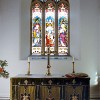In the parish church of Bloxworth near Bere Regis in east Dorset, visitors can see a memorial in white marble mounted high on the wall of a side chapel. The plaque is in memory of one of Stuart England’s most accomplished and controversial aristocratic statesmen or “principal secretary of state for life”; a figure as true to the soil of Dorset as Barnes or Hardy.
This colourful character was Sir John Trenchard. Trenchard was born in Lychett Matravers in March 1649, where his family had long held a manor, though from the late 15th century onwards the family seat was at Wolferton (or Wolveton) House. This house, near Charminster, had its foundations laid around 1480 by an earlier John Trenchard and his son Thomas, who in turn had inherited the estate through John’s marriage. Wolveton was originally conceived as a grand early Tudor mansion with Elizabethan additions, but was later largely demolished, and the present house is only the south west wing of the earlier one.
Thomas’s son, Sir George, had a daughter called Grace, who married into another of Dorset’s manorial families, the Strangways (Strangeways). Apart from his contribution to the building of Wolveton, Sir Thomas also embellished the 12th century church of St.Mary at Charminster by adding its imposing west tower. He also held office as Sheriff of Somerset and Dorset in 1509 and 1523, but is probably best known for hosting Archduke Phillip of Austria and his wife Juana (Joanna) at Wolveton after they were shipwrecked off the Dorset coast in the great storm of 1506. The story then follows that Thomas recruited a kinsman, John Russell, to act as his interpreter as he could not speak Spanish. James I in 1613 knighted Thomas.
Sir Thomas had a son – also called Thomas – born in 1615, who became the father of the later Sir John of Lytchett. The Trenchards were a family of longstanding puritan and parliamentary leanings. Two cousins, William Sydenham and John Sadler, were both soldiers and administrators in the service of Cromwell, and as he grew up John came to detest the unprincipled court life of Charles II. From the age of 15 to 18 John attended New College Oxford without obtaining a degree and went on to study law at the Middle Temple. Here he met up with Hugh Speke, a distant relative and son of Sir George Speke of White Lackington. (Sir George Trenchard’s wife was Ann Speke).
In association with his cousins John joined the Blue Riband Club, a society of agitators meeting at the King’s Head Tavern in Fleet Street. Although there was never any evidence of his being involved in Titus Oates’ famous popish plot, Trenchard would certainly have been an anti-papal sympathiser. When he was 30 in 1679, John entered Parliament to represent Taunton, and joined those who wished to bar the Duke of York from the throne. He attended meetings held by the dissidents, who were concerned that the Duke would attempt to restore Catholic prominence in England. In 1682 Trenchard married Hugh Speke’s sister Phillipa, then 18.
In 1683 some dissidents hatched a conspiracy to murder the King and his brother in Hertfordshire as they returned from the races at Newmarket. The Rye House Plot, as this conspiracy came to be known went wrong, casting suspicion on Trenchard and his cronies. Together with Lord Russell and Algernon Sydney he was arrested and sent to the Tower. (Interestingly, he was later able to recover his own arrest warrant, now in the archive of the Dorset County Record Office in Dorchester). Russell and Sydney were subsequently executed, but Trenchard appears to have turned his coat with sufficient alacrity to escape the same fate by possibly agreeing to pose as a double agent supplying the government with intelligence about anti-Stuart sedition in the west country!
As no concrete evidence could be levelled against him, Trenchard was released. While John was staying with his father-in-law at Illminster in 1685, the Duke of Monmouth landed in Lyme Bay to raise his notorious rebellion against the King in support of his claim to the English crown. With the suspected assistance of George Speke, John was compelled to escape back to the manor at Lytchett while it was still under surveillance by law officers. His servants then made arrangements to get him aboard a ship berthed at Weymouth. Trenchard then spent two years of exile in Holland; George Speke also fled the country. (Visit Archived Articles Section and click on ‘The Monmouth Rebellion’ Pub.August 2002. Ed.)
Meanwhile Hugh Speke, by then John’s brother-in-law, had been jailed for writing anti-Stuart pamphlets. Officers of the King also raided the Speke home and arrested Hugh’s brother Charles, who was summarily executed by hanging from a tree in Illminster market place. The King’s officers were in no doubt about where the family’s loyalties lay. During a tour by Monmouth of the West Country in 1681, George Speke had entertained the Duke and pledged his support for any future claim to the throne the Duke may assert.
During his two years of exile in the Netherlands Trenchard had made the acquaintance of William of Orange, the Protestant son-in-law of James II. It is believed that on his release from prison, Hugh also fled to Holland. However, in 1686 a general amnesty was issued for the exiles, largely brought about by the intervention of the Quaker William Penn, though Trenchard himself was not pardoned. Yet by the end of 1687 he was back in Dorset, probably as a consequence of offering service to the King in return for his liberty.
With the immediate danger over, Trenchard was able by 1688 to resume his parliamentary career. That year he was elected to represent Dorchester as the leading Whig (i.e. the gentry-party opposed to the Tories of the Court). In this capacity he made an unsuccessful bid to persuade King James II to tone-down his pro-catholic sympathies for the sake of the country’s peace. But the birth of a son to James that year threatened a papal succession once again. The Whigs and Tories united to invite William and Mary to claim the throne. Trenchard of course easily slipped into favour with the royal couple, although he took no active part in the revolution, which ousted James.
John Trenchard was knighted in 1689 and made Chief Justice of Chester. The following year he was elected member for Poole and appointed Secretary of State in 1692. In this capacity he adopted a distinctly draconian approach to the country’s security, setting up an elaborate spy network to oversee the exiled King James, then under the protection of Louis XIV. In the archives of the Bastille were letters revealing that Trenchard had very high level contacts in the French Court and that he had spies in the French channel ports who relayed information from French naval officers.
At home Trenchard was no less zealous in his anti-papal purges. He courted great unpopularity by persecuting those he thought to hold Jacobite sympathies and freely issued search warrants for their homes. Once, when on the trail of a bogus plot perpetuated by one Francis Taffe, Trenchard was much reviled for his gullibility, though he was a man impervious to criticism.
By spring 1695 Sir John Trenchard was in poor-health, and by the end of April he was dead. He was just 46 years old. Phillipa however was not widowed for long, marrying soon after a merchant named Daniel Sadler and living for almost another 50 years. By Phillipa, Trenchard had seven children. His three daughters, Elizabeth, Mary and Anne all married well, though only one of his four sons survived to adulthood.
It should be noted that there were John and Thomas Trenchards in two other possible branches of the family, which could lead to considerable confusion about who is meant. For example there was also a John Trenchard of Warmwell (1586-1662), and a literary John Trenchard (1662-1723), the author of ‘A Short History of Standing Arms in England’ (1698 & 1731) and ‘The Natural History of Superstition’ (1709).
Footnote:
Thomas Gerard in his book Coker’s Survey of Dorestshire (1732) wrote: “Bradford Peverll. The Seate for a longe time of the antient Familie of Peverells whose estate about Henry the Eighth’s time fell by a Female Heire to Nicholas Meggs and his Posteritie enjoy it. Neare Bradford the River dividing itself, making an Island of manie faire and fruitful Maedowes, and there joineth againe a little belowe Dorchester, the more northern branch, being the lesser, amongst these Maedoes runneth by Wolton, more trulie Wolvehampton, a fine and rich Seate which (by the daughter and Heire of John Jordan the antient owner of it) came to John Mohune. His only daughter and Heire Alice brought a faire Estate unto her husband Henry Trinchard of Hampshire whose Grandchilde Sir Thomas Trinchard, gracious with King Henry the Eighth was called chief Builder of the Habitation of Sir George Trinchard, a Man of Great Courage.” (See our article: ‘ Thomas Gerard of Trent’ Published 17th July 2011, in the Trent category.)



